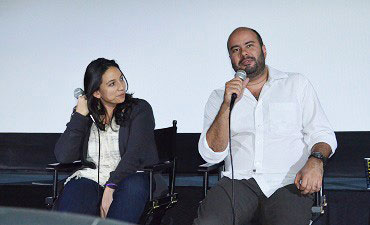Embrace of the Serpent is a surreal and stunning film inspired by the real journals of two explorers, Theodor Kock-Grünberg and Richard Evans Schultes, who venture deep through the Colombian Amazon in search of a rare, healing, hallucinogenic plant. They are guided, at separate times forty years apart, by a Colombian shaman named Karamakate. "We started with a film that was very Western in its narration," said Director Ciro Guerra in a Q&A session with LAWAC on Tuesday, February 9th. "After spending a lot of time with the Amazonian people, it became something different," he said. "We had to give the protagonist to them, to their story." The local people played big roles "in front of and behind the camera."
The main plot centers on Karamakate, the last survivor of his Amazonian tribe and a witness to the drastic changes on South America's landscape and indigenous peoples wrought by Westerners. "He's a complex character with multiple dimensions," said Guerra of Karamakate's life journey as it is chronicled through the film. "There are terrible decisions that bring on terrible things."
Embrace of the Serpent was filmed in just 7 weeks with a crew of forty people. The majority of the cast were Amazonians and not trained actors, including Karamakate, and they only had 2 months to prepare for their roles. "They were all indigenous," said Producer Cristina Gallego of the cast that helped them translate the 9 languages included in the script. After they finished the film, their team had to build a theater for the Amazonians to see it. Asked what they thought of it, "They were completely surprised," said Gallego. Asked why the movie was filmed in black and white, Guerra said, "It just couldn't be filmed any other way." He said the idea stemmed from seeing original images recorded by the explorers.

Q&A with Producer Cristina Gallego and Director Ciro Guerra
Capturing the Amazonian culture and older stories from their ancestors is what Guerra and Gallego aspire to bring to the big screen. "We were looking for a way for the film to build a bridge to the Amazonian way of thinking and the Amazonian way of understanding the world that is completely different from our own," said Guerra. "The Amazon was seen by most Colombians for a long time as a very dangerous place to go to," said Guerra. "In a way, cinema is helping us to take back the country, to be able to go back and look at it."

